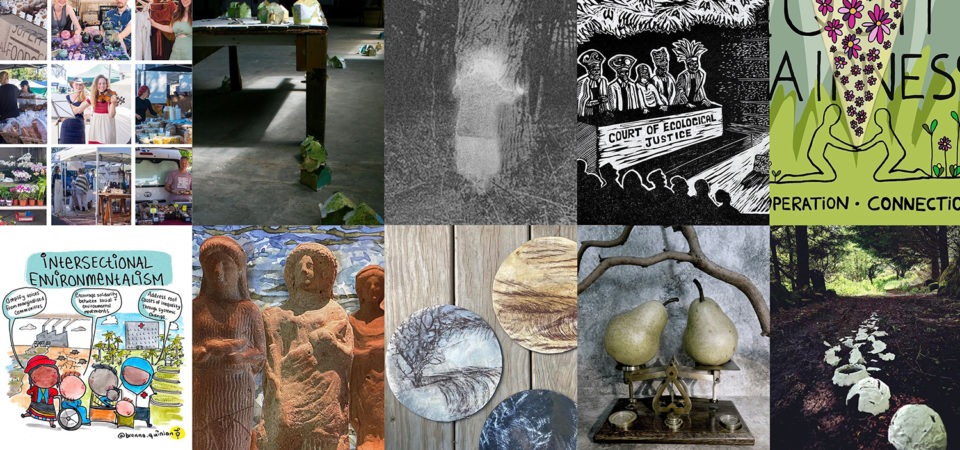Online Exhibition opened July 25, 2023
Featured Artists
Kirsten Aaboe, Marie Cameron, John Cloake, Alison Lee Cousland, Yvonne C Espinoza, Ries Faison, Diane Farris. Hillary Irene Johnson, Jacqui Jones, Deborah Kennedy, Michalina Klasik, Nancy D Lane, Doris Langer, Rosalind Lowry, Meredith Nemirov, Brenna Quinlan, Peggy Rose, Susan Smith, Kim Tanzer, Marcela Villasenor.
This is the 17th What’s Next for Earth online exhibition based on Think Resilience, a free online course written by Richard Heinberg and produced by Post Carbon Institute.
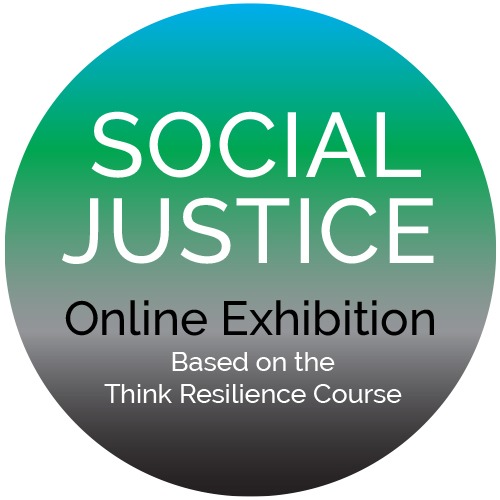 What’s Next for Earth follows the course, one lesson per art call. To respond to this art call, we asked the artists to signup and watch the course. The transcript of the lesson “Community Resilience and Social Justice / Equity / Ownership” is here. This exhibition is part of the fifth chapter of the course: Economy and Society.
What’s Next for Earth follows the course, one lesson per art call. To respond to this art call, we asked the artists to signup and watch the course. The transcript of the lesson “Community Resilience and Social Justice / Equity / Ownership” is here. This exhibition is part of the fifth chapter of the course: Economy and Society.
“Systemic inequality reduces the sustainability and resilience of society as a whole. Capital tends to reproduce itself and become more consolidated and centralized over time—that’s its purpose—but only some members of society are motivated or able to set aside money and goods for the purpose of capital accumulation. Inequality is also created, sustained, and worsened over time through institutionalized racism, which results in chronic conditions of poverty and lack of access. Ultimately, promoting equity will require strategies like cooperative ownership of business and expanding the commons—the cultural and natural resources that should be accessible to all members of a society, and not privately owned.”
– Richard Heinberg
Video transcript of the lesson here.
Exhibition

Marcela Villaseñor
THE BORDER
2009/2023
digital collage
The American Dream for immigrants most of the time is impossible because of the institutionalized racism and the inequality of social justice.
“The cultural and natural resources should be accessible to all members of a society, and not privately owned.”
Richard Heinberg
©2023 Marcela Villasenor
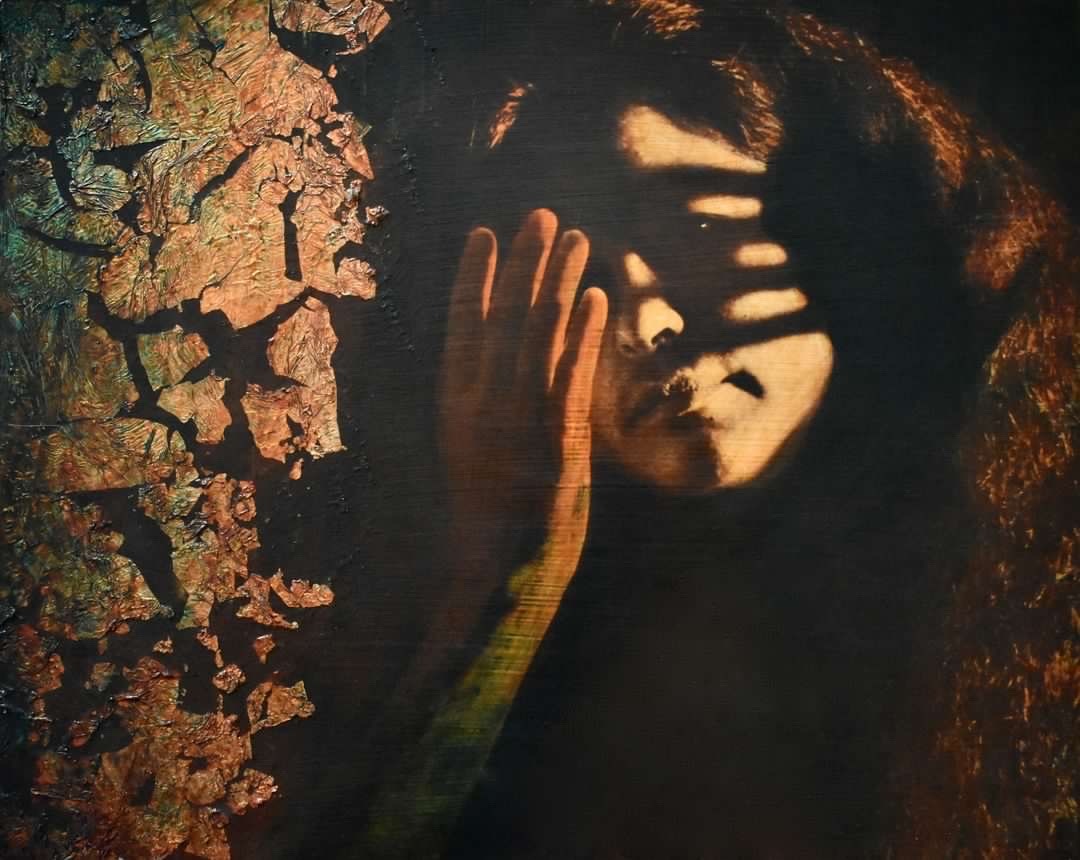
Deborah Kennedy
WALLS WITH: CONSUELO
Altered photo
The Enlightenment, a French 18th century philosophical and social movement, advocated using reason, knowledge and science to guide society and improve the world for the benefit of all people. They promoted tolerance and embraced open access to knowledge and education for all. This powerful movement helped triggered the American Revolution and the United States’ extraordinary leap into a unique democratic experiment. The Enlightenment fostered the embrace of equality and diversity by many new democracies. Over time people realized a diverse, socially just society was more resilient, flexible, and creative. Today, many democratic experiments around the world seem vulnerable and unstable as right wing, autocratic forces show a shocking rise in power. Sadly, these forces are not only destructive to our social fabric, they also frequently undermine the health of our natural world. When will we see the value of human diversity, and also see the extraordinary value of a natural world teeming with diversity.
©2023 Deborah Kennedy
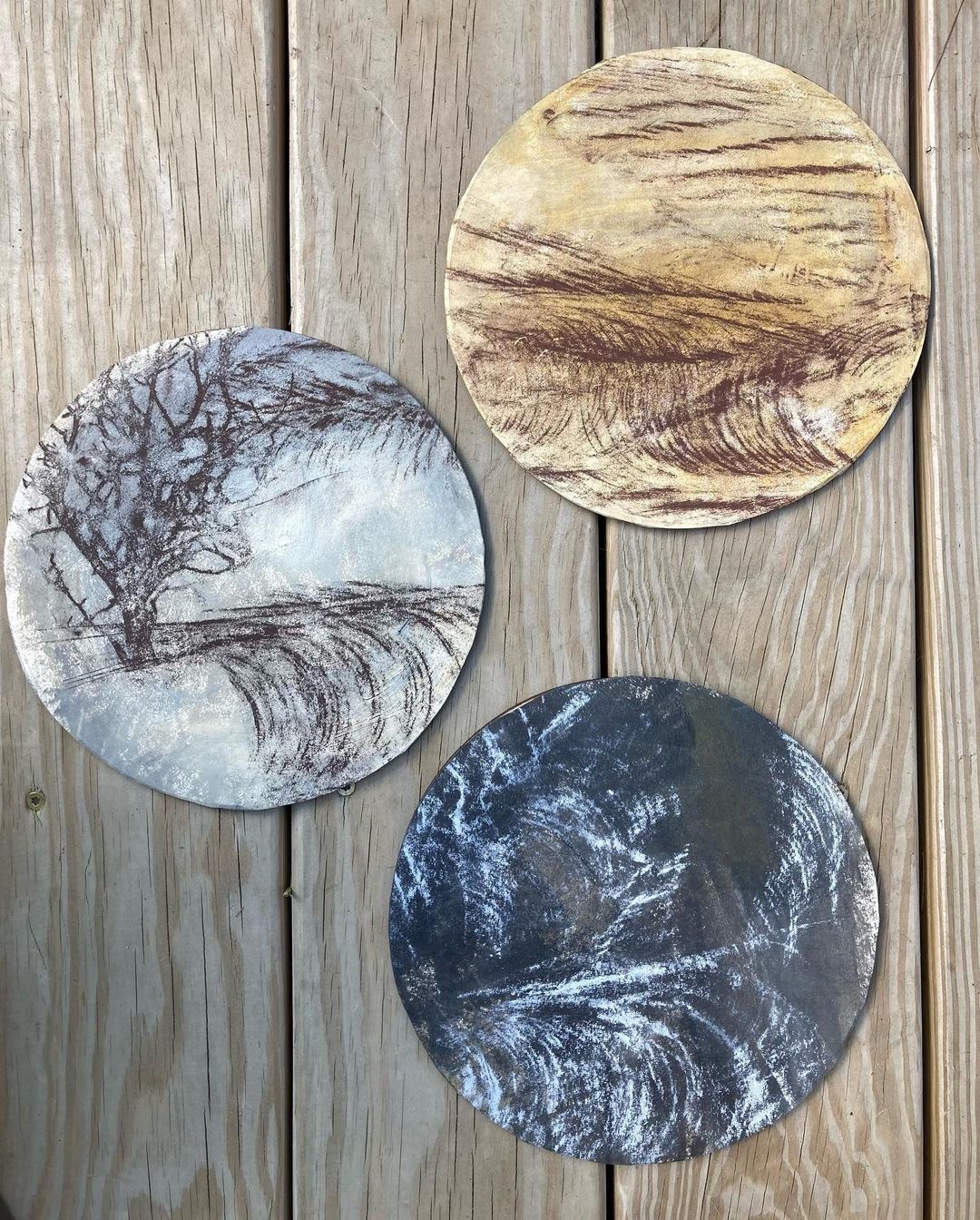
Susan Smith
FROM THE POINTS OF INTEREST SERIES
Shell pigment, burned construction materials, plant based pastel with PFAS contamination, rubbings on laser cut wood remnants.
2023
Ongoing series marking geographic locations of environmental urgency. Research and narratives collected in these communities, and found materials used to create each point. Shown: Sears Island (ME), Dalton (GA), and El Paso (TX).
©2023 Susan Smith
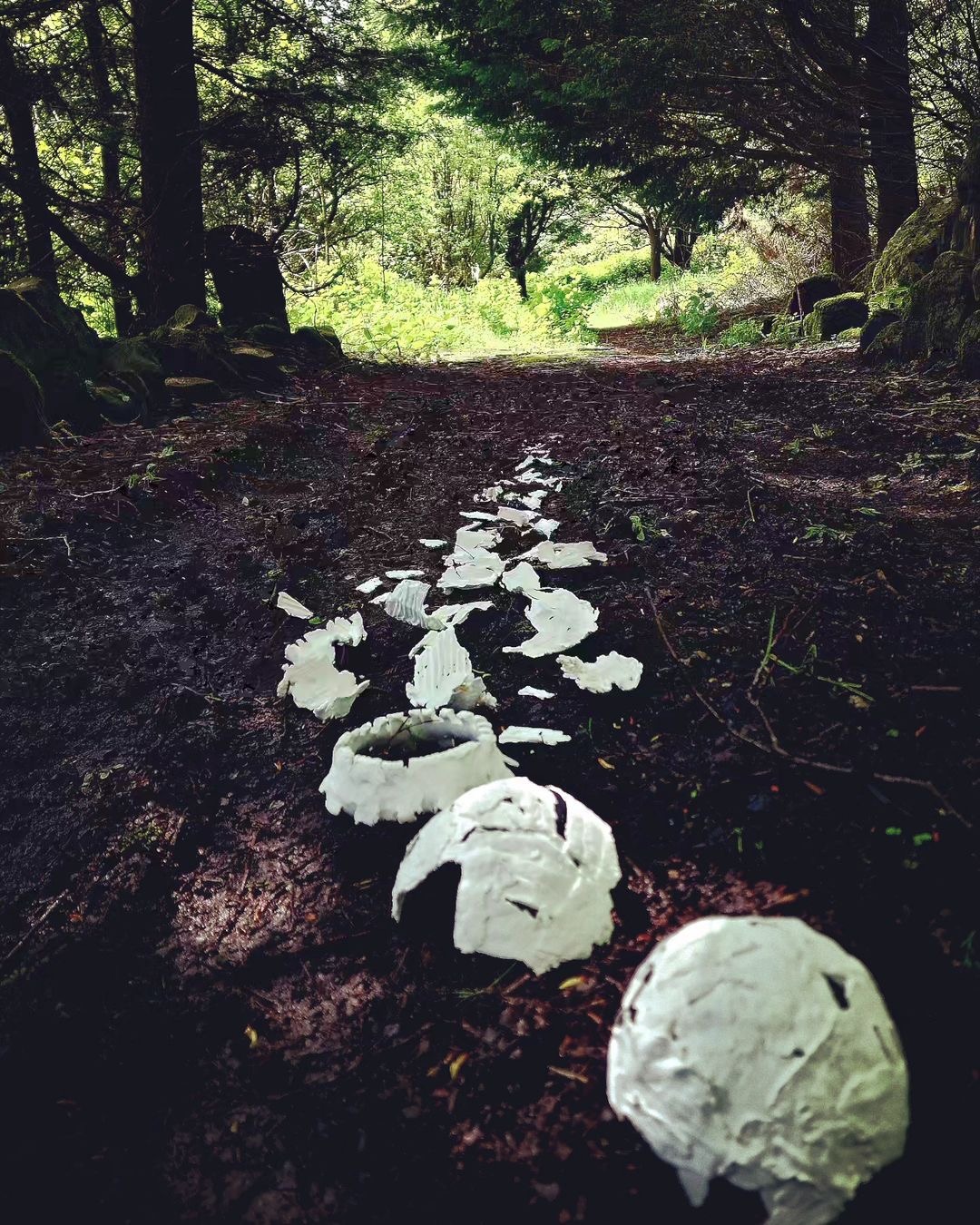
Rosalind Lowry
PREDATOR FENCE
Materials: Porcelain
2ft x 10ft
Location: Private Land, County Antrim, Northern Ireland.
A new installation on private land, specifically for the @whatsnextforearth Social Justice artcall for Stanford University & The Millennium Alliance for Humanity and the Biosphere, a programme I’ve been involved in for over a year now. Generations ago, common land in Ireland was gradually enclosed with fences and claimed as private property by organisations and people wealthy enough to get away with it. People who lived off this land had to rent it back or work for the ‘landowners’. Social Justice highlights that no human being made the land or the rivers or the sea, so why then should a person or a corporation be entitled to extract wealth from it?
©2023 Rosalind Lowry
Kim Tanzer
HOMMAGE TO DRESSED YARDS
Video
In towns and cities throughout the American South, African- American neighborhoods have grown up as distinct enclaves within larger urban areas. These neighborhoods, often indistinguishable from other residential areas on city maps, are remarkably different when seen first-hand. A particular range of colors, architectural elements, elaborate front yards and symbolic displays are consistent within and between African American neighborhoods, but nonexistent in other areas.
Neighborhood residents’ common space-making strategies lead to a continual community-wide spatial conversation, which might be characterized as urban-scale performance art. While many neighborhoods could illustrate this singular performance of community, I have found none that do so more successfully than the Fifth Avenue/Pleasant Street neighborhood in Gainesville, Florida.
This video presents a small sampling of specific communal strategies, some handed down through the many generations of the African diaspora. These include call-response gestures, symbol “sampling,” and “signifying” all set in the context of what art historian Grey Gundaker calls “dressed yards.” The streets and their dressed yards form the community’s commons.
As Richard Heisenberg explains, “In most pre-industrial economies, the commons included sources of food as well as natural materials for making tools and building shelters. Everyone who used the commons had a stake in preserving it for the next generation.”
This neighborhood acts as a cooperative, described by Heisenberg as “deliberately foster(ing) voluntary and open membership, democratic member control, member economic participation, cooperation among cooperatives, and concern for community.”
It provides important lessons for all of us.
©2023 Kim Tanzer
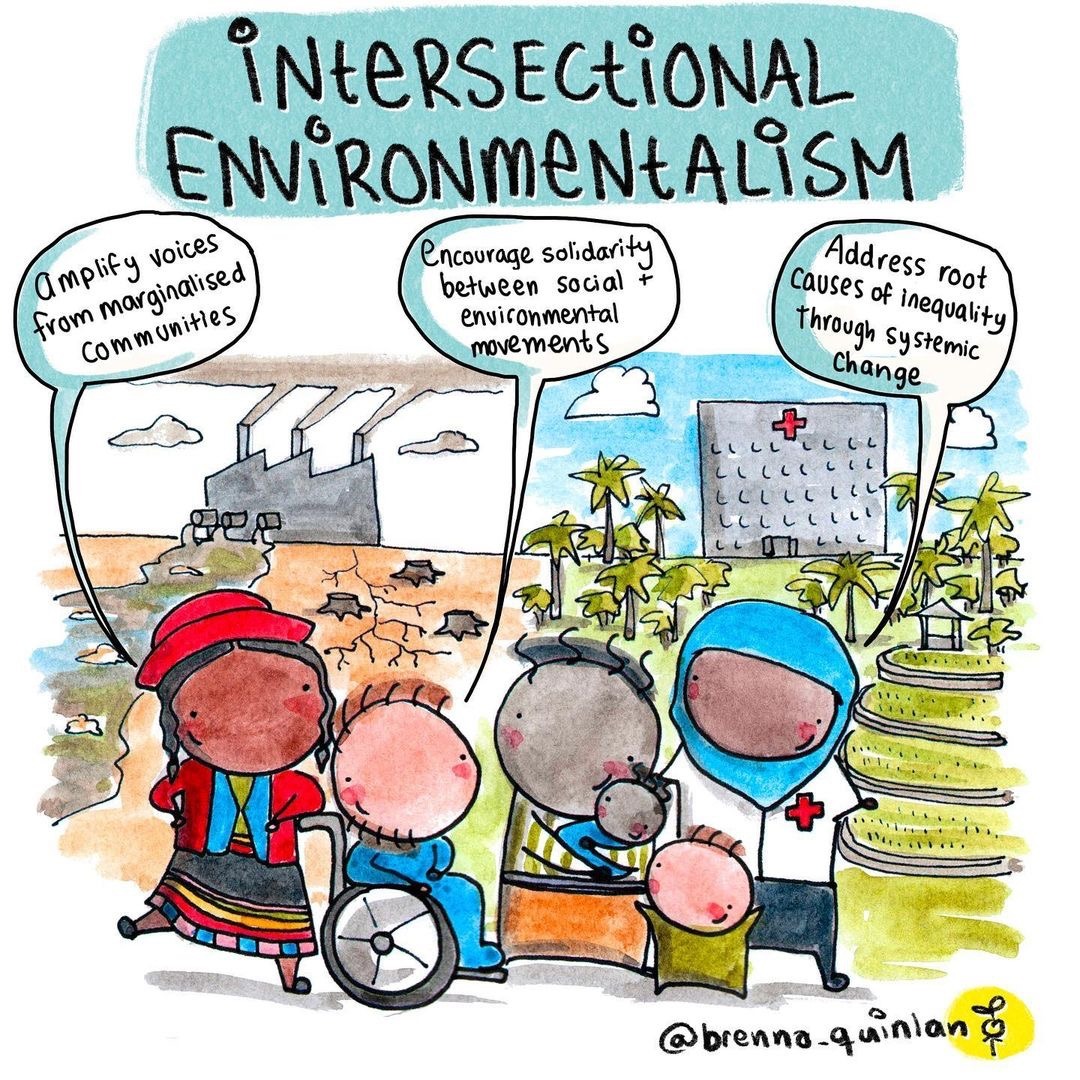
Brenna Quinlan
INTERSECTIONAL ENVIRONMENTALISM: WHAT IS IT?
Drawing
It’s all about inclusivity in the environmental movement. It’s the answer to that uneasy feeling you get when people talk about the planet being better without us, or the tension that arises when climate action and social justice are painted as two separate and competing causes. It’s a focus on climate justice, a conscious acknowledgement that people and planet are one, and that environmental action is stronger when it uplifts the people involved.
The phrase was popularised by @greengirlleah when she called for the environmental movement to stand in solidarity with #blacklivesmatter. It builds on the important work of @kimberlecrenshaw who described intersectionality as an exploration of the way overlapping systems of power affect those who are most marginalised by society. It is a wholistic way of understanding oppression, and when applied to activism, it helps us to consider all bases, and understand the disproportionate impacts that climate change and other forms of environmental degradation have on certain groups.
Intersectional environmentalism helps us walk towards a world where people and planet are thriving. To get there, we work to amplify the voices of those who are marginalised, encourage solidarity between social and environmental movements, and push for systemic change to address the root causes of inequality.
We are in a time of great change, and it’s exciting to see how the movement morphs and shifts to improve itself as it matures, too the benefit of everyone.
©2023 Brenna Quinlan
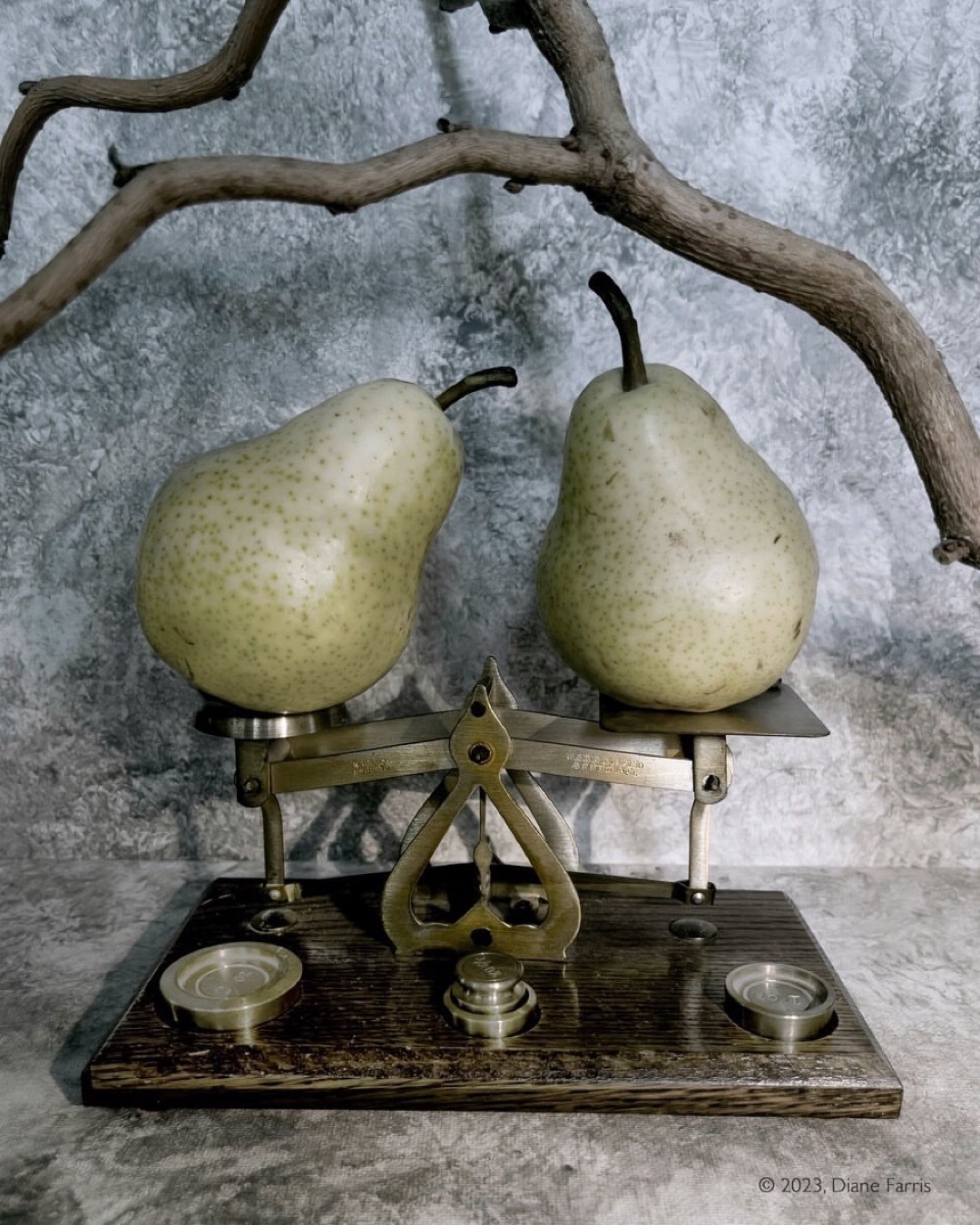
Diane Farris
EVEN
Photograph
Richard Heinberg’s summary sentence “Resilience and sustainability require justice” brought to mind an image of the classic scales of justice and WNFE’s current call. I found and began sketching my father’s old balance scale. As my first solutions (to many situations) often revolve around gathering, gardening, cooking and coming together around a welcoming table, food was a natural for the balance. And ,sculptural pears were on hand. Heinberg writes of “expanding the commons”, evoking a town square, village green, a farmer’s market, all images of gathering to share resources for the common good, the traditional “common weal”. The somewhat enigmatic “Even” appeared as a title early in the process, but Roget’s Thesaurus offered meanings that fit: “level, unbroken, on a par, proportionate, just…”.
©2023 Diane Farris
Meredith Nemirov
WATER (IN)JUSTICE: ANCIENT COMMUNITIES TO CONTEMPORARY
Three photographs
Collage, photography with watercolor
2023
View Gallery
“Resilience and sustainability require justice”
–Richard Heinberg from the Post Carbon Institute
Photo 1: These figures from 5th c. BC Greece represent a society. Aristotle’s belief in natural law states that essential rights such as equal access to air, water and an inhabitable Earth supersede the laws of man.
Photo 2: This clay head depicts the river god Acheloos associated with the Achelous River, the most powerfully flowing in Greece.
Photo 3: The Colorado River Compact 1922 allocated water to 7 states. Native Americans were excluded from this agreement. The Colorado River has been the lifeblood of the Southern Utes since 1300. In the 1960’s the federal govt. started to address how much water the tribes could take from the river. We hope that all parties examining this outdated agreement will move forward keeping in mind the concept of Social Justice in allocating water to all members of society. Photograph from the SouthernUteArchives.
©2023 Meredith Nemirov
Alison Lee Cousland
IN GRATITUDE TO AND SUPPORT OF MY LOCAL SUSTAINABLE ORGANIC FARMERS MARKET
Photographs
I am blessed:
To be able to go to a place where I can connect with like minded/hearted and spirited people.
To be able to connect with the people who care for the land and all it produces: Which finds its way to my table.
‘The word blessing evokes a sense of warmth and protection: It suggests that no life is alone or unreachable. Each life is clothed in raiment of spirit that secretly links it to everything else.’ ~John O’Donohue.
I would also like to echo Richard Heinberg’s thoughts on Social Justice/Equality/Ownership: ‘Resilience and sustainability require justice/equality.’
Slide 1. Shopping out-of-doors is so much more relaxing and enjoyable: Stallholders become friends, and virtually every basic need, from clothing to crystals: food to flowers, can be met.
Slide 2: Just a small sample of some of the products.
Slide 3: Some of the ‘icons’ at our particular market: Like Rocco on the top left was the son of a man who began selling his own organic vegetables way way back when we first started going to our local Organic Farmer’s Market.
Rocco’s fame is his range of HOT chilli and curcumin sauces and his son and grandchildren now help him man his stand.
©2023 Alison Lee Cousland
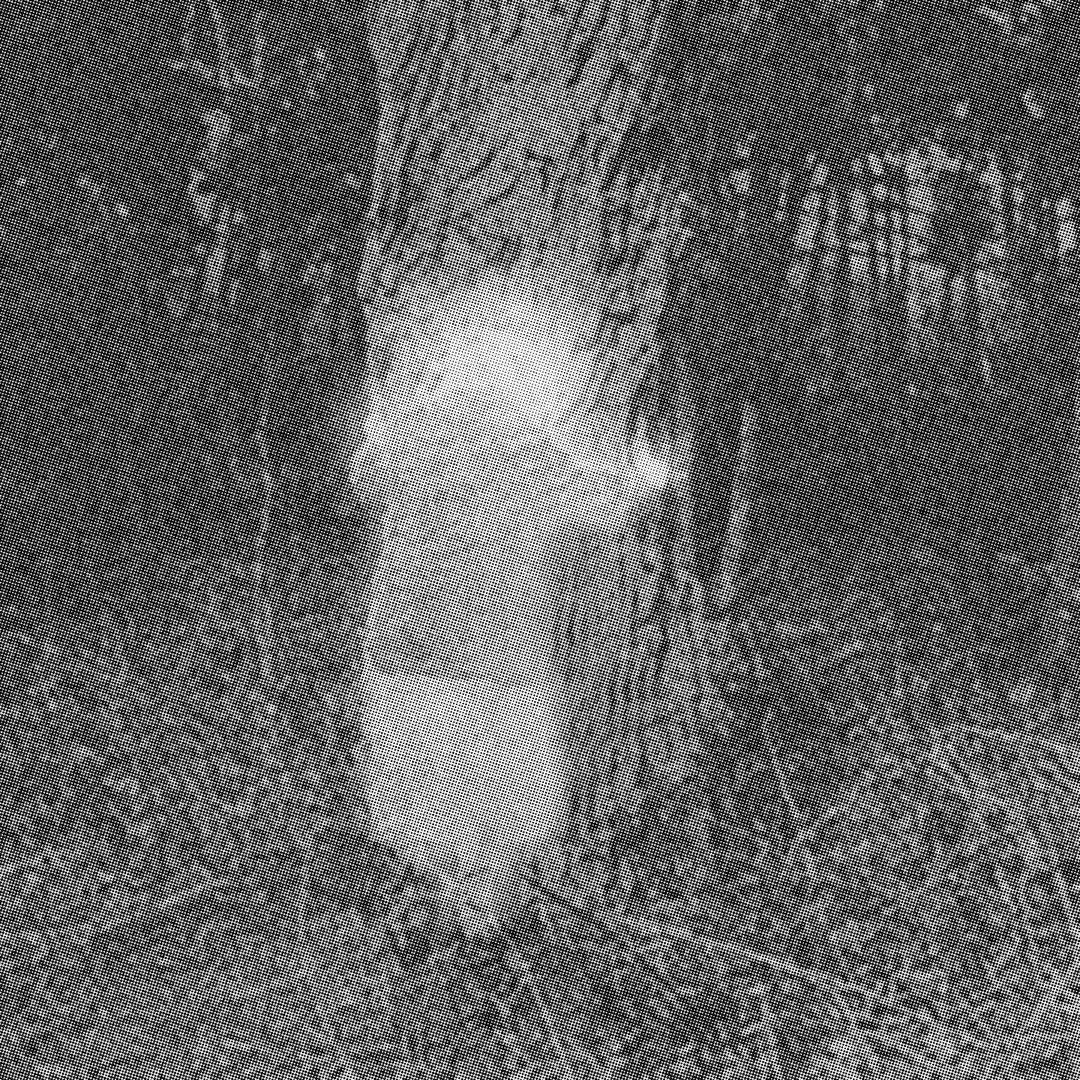
Michalina W. Klasik
WORK FROM THE “TREE-HUGGERS” SERIES
UV print on glass
35x35cm
2023
“A truly resilient community must foster equity and democracy, as well as ecological renewal.”
–Richard Heinberg
©2023 Michalina W. Klasik

John Cloake
COURT OF ECOLOGICAL JUSTICE
Linocut on Japanese Hosho paper
30x20cm
I am posting this piece from my “Climate Crisis” series in support of the MAHB art call on Social Justice. I believe it aligns closely with the following comments made by Richard Heinberg in the “Think Resilience” course, “Of course, equity in communities is not just a matter of ownership and income. Access to political power, public services, and legal protections are just as important. Laws are the rules that determine how we all coexist in community, and politics is the process by which we make and enforce those laws. If all community members do not have fair influence in how governmental policies are made, then inequities can arise in any number of ways.”
I agree. The idea of a small number of individuals (sadly even including rulers of states) and enterprises destroying the earth’s common resources for profit or power is no longer acceptable let alone sustainable. But I would go even further and observe that legal protections must extend to those elements of the planet that have no voice.
My vision of a Court of Ecological Justice, includes a panel of judges who will of course consider narrower human interests but also act as specialist advocates for the silent voices of the animal life, marine and land habitats, the skies and air and of our children and their successors. In this image each of the judges wears the symbol of their allocated voice.
©2023 John Cloake
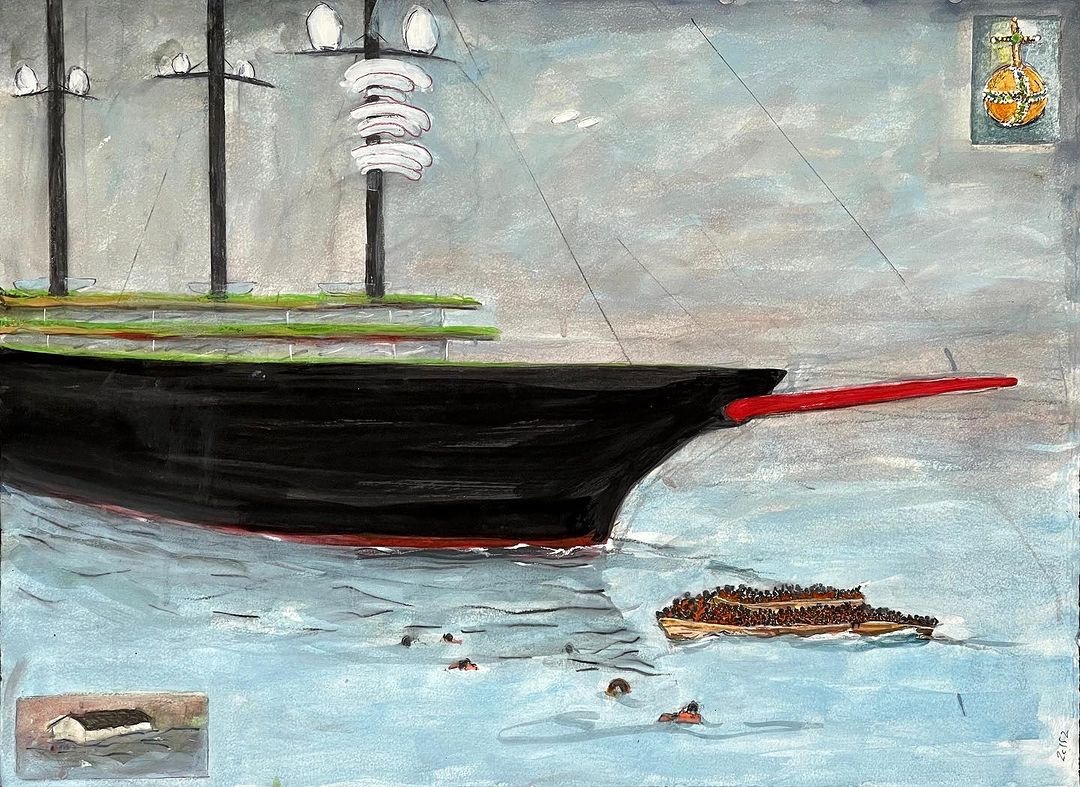
Dorothy Ries Faison
HOW BIG A BOAT DO YOU REALLY NEED?
watercolor and water soluble crayon on paper
22 x 30 in 56 x 76 cm
2023
“Resilience and sustainability require Justice … A truly resilient community must foster equity and democracy, as well as ecological renewal.”
“300 individuals ENJOY as great a share of the world’s wealth as the poorest half of humanity (four BILLION people)” –Richard Heinberg, Post Carbon Institute
Recent events in the Mediterranean and Atlantic Oceans drive home this gross and immoral inequity that has worsened as more and more wealth has flowed to the very few.
©2023 Dorothy Ries Faison
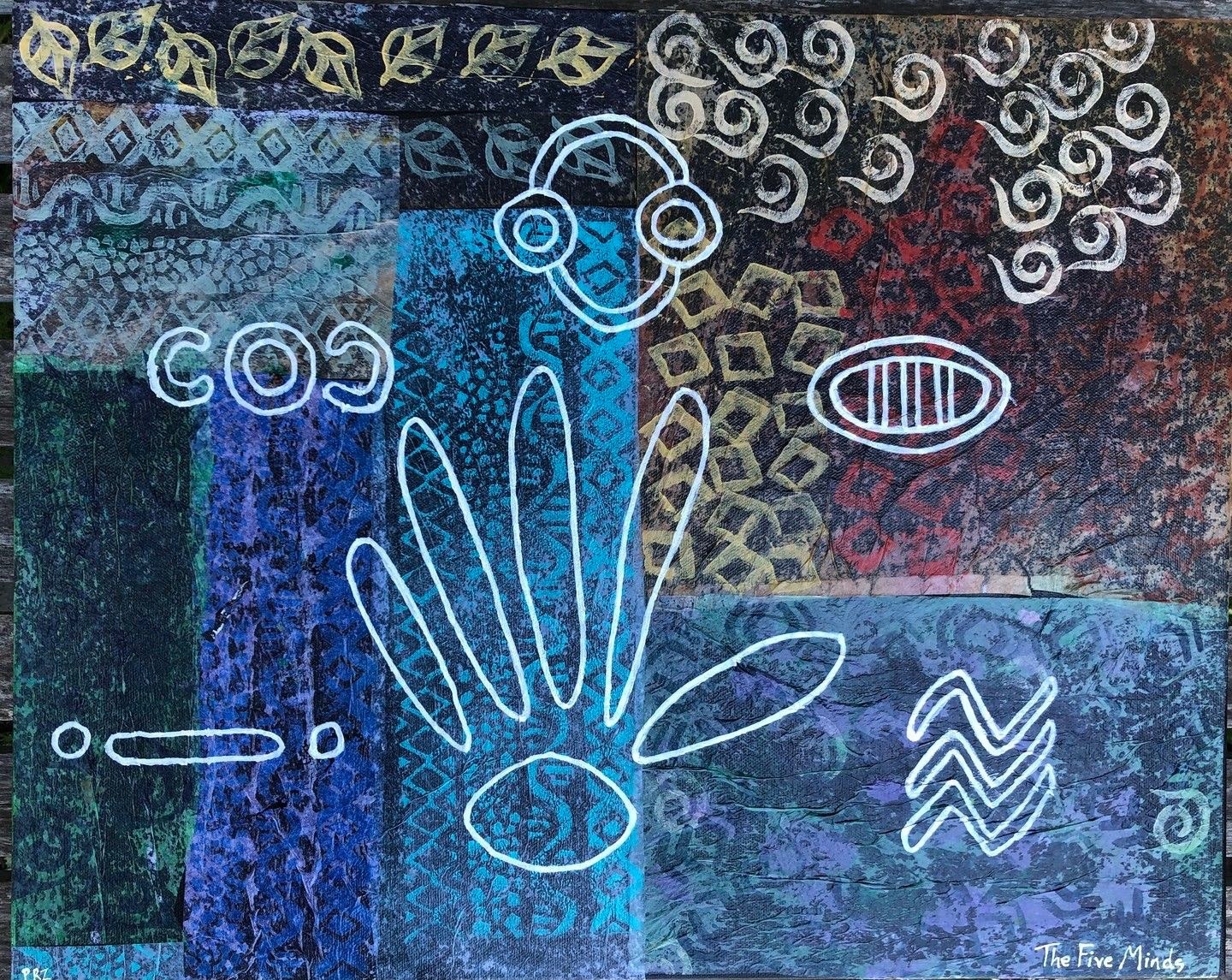
Peggy Rose
THE FIVE MINDS
Tissue paper and acrylic paint on canvas
16″ x 20″
“Systemic inequality reduces sustainability and resilience.”
The content of this piece comes from Tyson Yunkaporta’s book Sand Talk. He invites us to see the world from the indigenous perspective rather than looking from our own perspective into the indigenous.
The aboriginal elders want this shared with the world.
Use the hand to remember the five minds. The little finger is the kinship mind. Nothing exists except in a relationship. The ring finger is the story mind because we all hold knowledge, and sharing is how we increase knowledge. The middle finger is a turnaround mind, from the abstract to the concrete, in an ever-revolving force linked by metaphor. The pointer finger is the ancestor mind, present when anything is done with deep engagement and intense concentration. The thumb is a pattern mind. This is systems thinking, contextual, holistic, and relational. Pause and look at the world through this lens.
Richard Heinberg quote: “Resilience and sustainability require justice. Therefore much of the leadership for resilience-building efforts must come from communities on the frontlines of ecological disruption.”
©2023 Peggy Rose
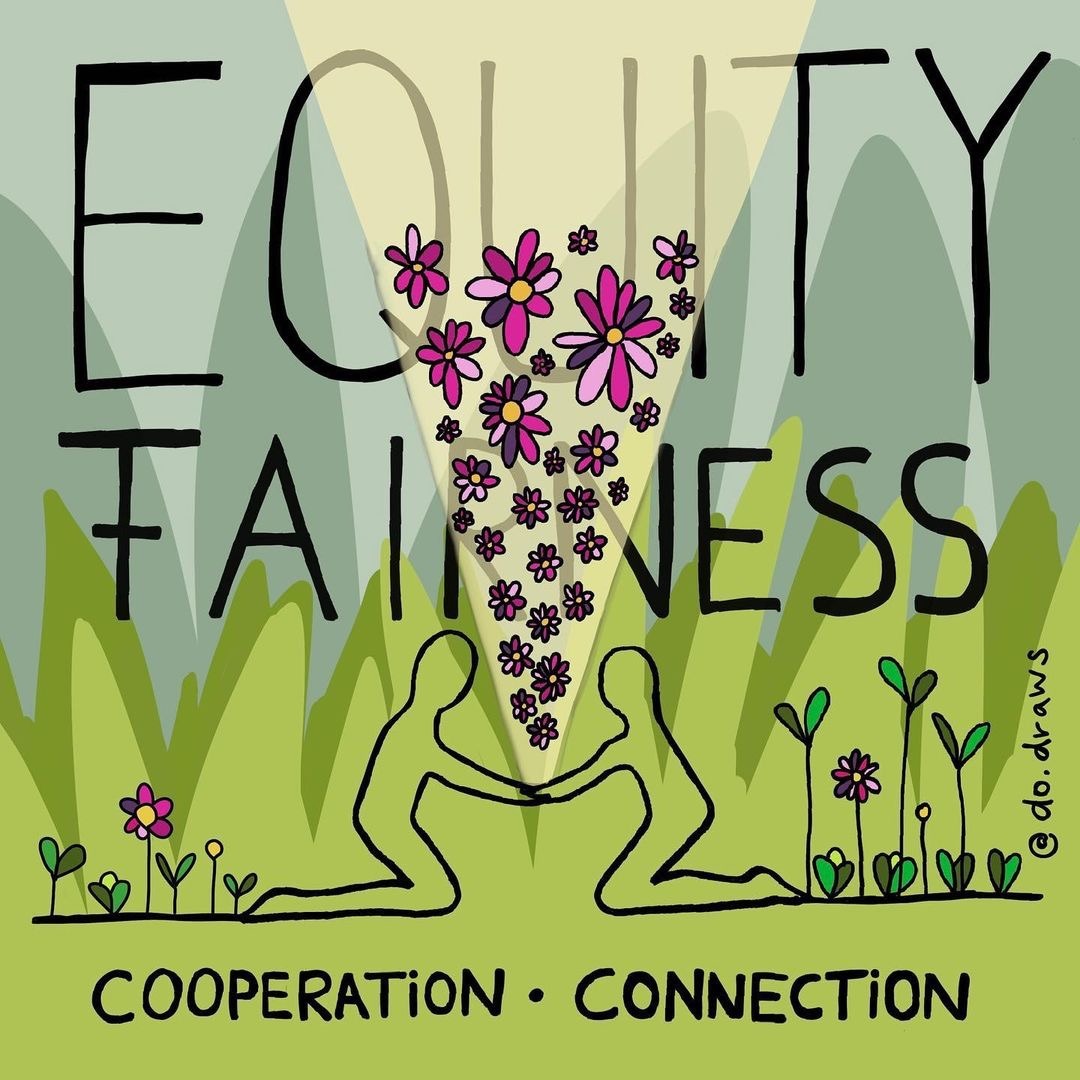
Doris Langer
EQUITY, FAIRNESS, COOPERATION, CONNECTION
Digital illustration
2023
I am taking part in the Social Justice Art Call of the What’s Next For Earth Project in response to the Think Resilience course lesson #18: Social Justice.
An excerpt of the lesson reads: “(…) there are specific, immediately accessible ways to build equity in our communities through common ownership. One way is through the promotion of cooperative enterprises. The original purpose of corporations was to pool capital to achieve socially useful but risky purposes, like building a bridge or roadway. Cooperatives—or co-ops—pool capital as well, but they are owned by their workers and/or customers, thereby granting ownership to the very people most involved and interested in the enterprise.”
Cooperation and connection on a local community level in the forms of cooperative enterprises are crucial ways of creating equity and equality on a community level. I want to show with my piece that if we engage in true cooperation with each other everyone will benefit, and so will the community as a whole. The synergies of that would be positive, flourishing and thriving results in creating healthy, sustainable lives, households and communities.
©2023 Doris Langer
Jacqui Jones
WAR-TORN
Large scale installation
United Kingdom
The large scale installation illustrated was exhibited in 2022. The piece was created from over 50 burnt buildings made from maps representing areas of conflict. The artwork was set in a disused factory and traversed several levels. Some of the burnt houses were scattered on the floor, others were placed on tables or on the rungs of a ladder suggesting a hierarchy of inequality even in destruction. The maps expanded the vision of environmental, humanitarian and climate concerns at both a local and world wide level, showing the vulnerability of the world and its inhabitants. On many occasions one person’s justice is another’s injustice.’
Resilience and sustainability require justice. Therefore much of the leadership for resilience-building efforts must ultimately come from communities on the frontlines of ecological disruption’. Richard Heinberg, Think Resilience Course by the Post Carbon Institute.
©2023 Jacqui Jones
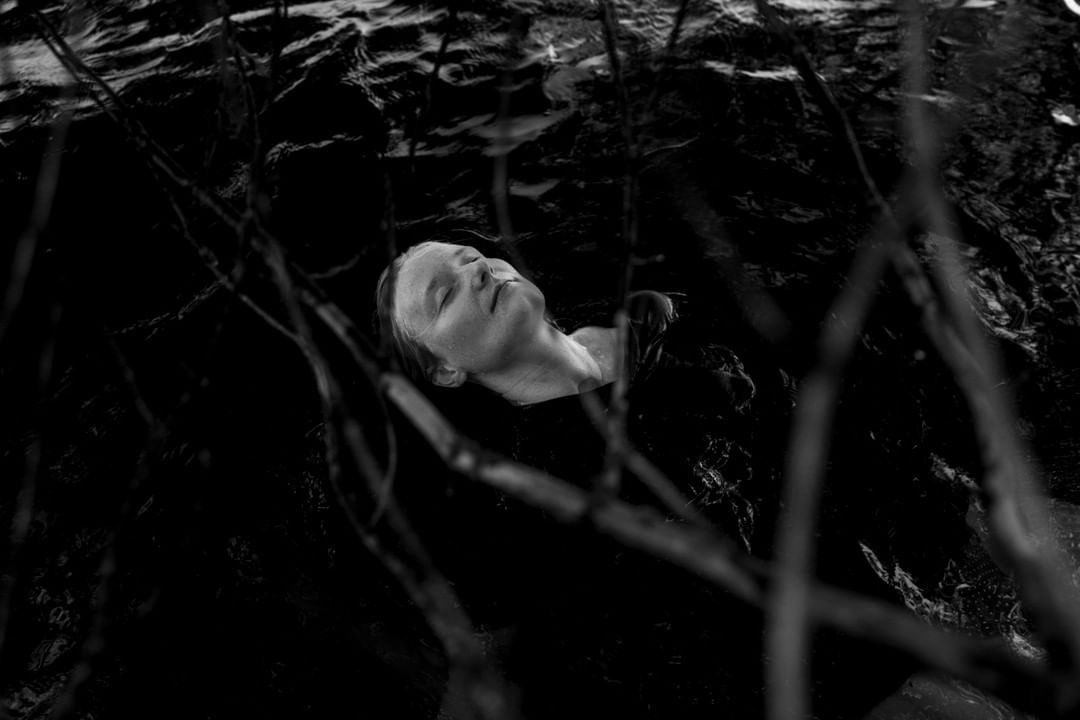
Hillary Johnson
THE DREAM OF RECIPROCITY
Photograph
Nova Scotia, Canada
I think of this portrait as a visual representation of inter-being with the commons of the land.
The image was made in a part of Canada that has been subject to all kinds of trauma, which has largely been created by extractive practices of fishing, logging, manufacturing, etc. These systems break the land and the individuals who reside there. The traumas are passed on generationally amongst the people and on the land and all of the many beings who dwell there.
These communities, when functionally properly, flow in perfect reciprocity, exist in balance, thriving and surviving far into the future, into the 7th generation. When we are out of balance, taking more than is needed, with action based on greed and harmful privatization, this is how we arrive at our current moment.
This photo is an invitation using the visual metaphor, seeing the water, air, trees, and humans as entwined. I hope a dream we can still realize.
“Meanwhile, there are specific, immediately accessible ways to build equity in our communities through common ownership. One way is through the promotion of cooperative enterprises. The original purpose of corporations was to pool capital to achieve socially useful but risky purposes, like building a bridge or roadway. Cooperatives—or co-ops—pool capital as well, but they are owned by their workers and/or customers, thereby granting ownership to the very people most involved and interested in the enterprise. And cooperatives have a long history of success. Credit unions are cooperative banks; some utility companies operate as cooperatives, and there are also housing, manufacturing, and agricultural cooperatives. The thousands of cooperatives across America deliberately foster voluntary and open membership, democratic member control, member economic participation, cooperation among cooperatives, and concern for the community.”
–Richard Heinberg, Community Resilience and Social Justice / Equity / Ownership.
©2023 Hillary Johnson
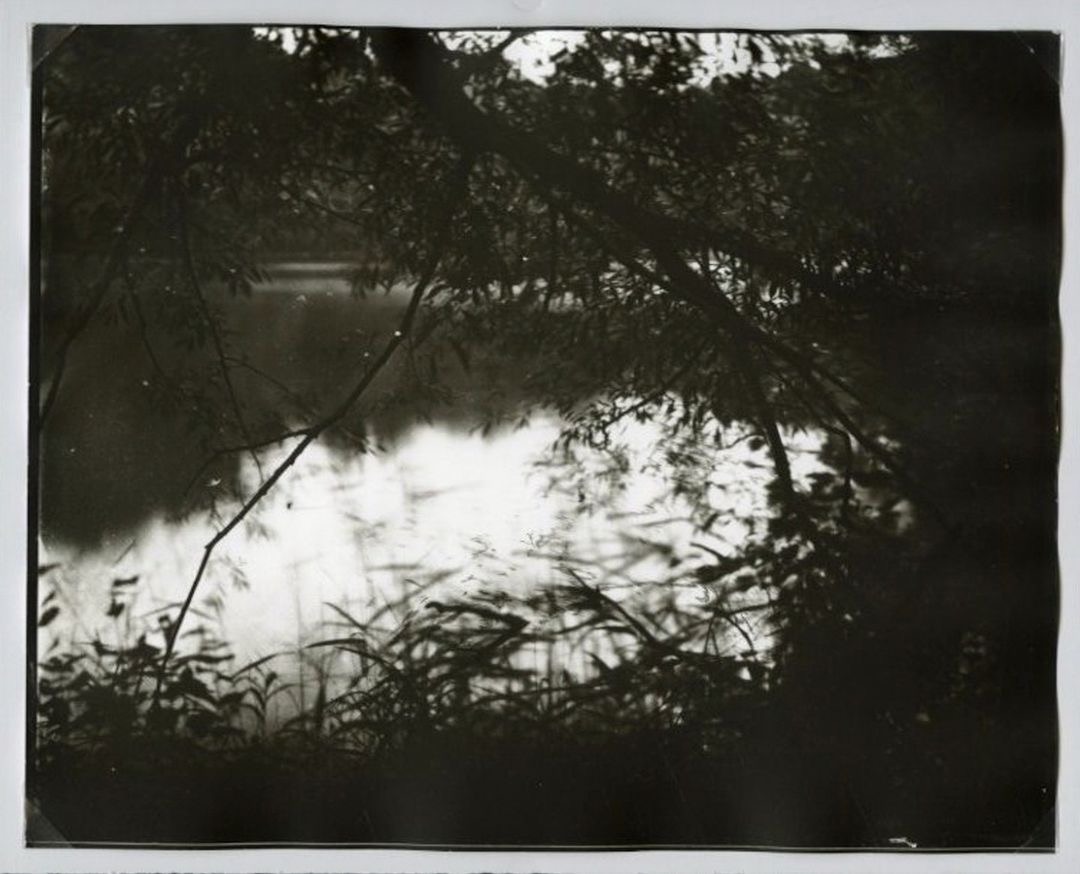
Hillary Johnson
VIEW OF A SUBURBAN POND
8″ x 10″ view camera
wet plate collodion, silver gelatin print
I used the collodion in this image both for its formal qualities, the smooth, grainless image, but also for its challenge to make a good glass plate and the alchemy of the process required, which feels so alchemical which references by feeling that the time we are in does ask of us a certain path is the alchemy of coming together to ask the big questions the course is asking us to consider.
This image was made in an area of communal property within a larger private space in a suburb outside of Chicago. It looks wild and is home to many creatures yet is surrounded by private homes and lawns which are not ecologically appropriate for the area. So there are tensions inherent in the image.
I also use the collodion as a nod to the early days of photography which also coincide with the beginning of the anthropocene, which might be thought of as the beginning of our time entering the great acceleration into technologies, the use of which propel us faster and faster into event horizons of seeking which we barely understand and are clearly with their dangers.
The content of this part of the course calls into question the matter of commons, both cultural and natural resources accessible to all members of a society, over those which are privately owned tensions which I hope this image begins to address both formally and conceptually.
“Everyone who used the commons had a stake in preserving it for the next generation. During and especially after the Middle Ages in Britain and then Europe, common lands were gradually enclosed with fences and claimed as private property by people who were wealthy and powerful enough to be able to defend this appropriation by law and force of arms. The American suburb presents an iteration of this set of challenges and that is one of the things in my investigations.”
–Richard Heinberg, Community Resilience and Social Justice / Equity / Ownership.
©2023 Hillary Johnson
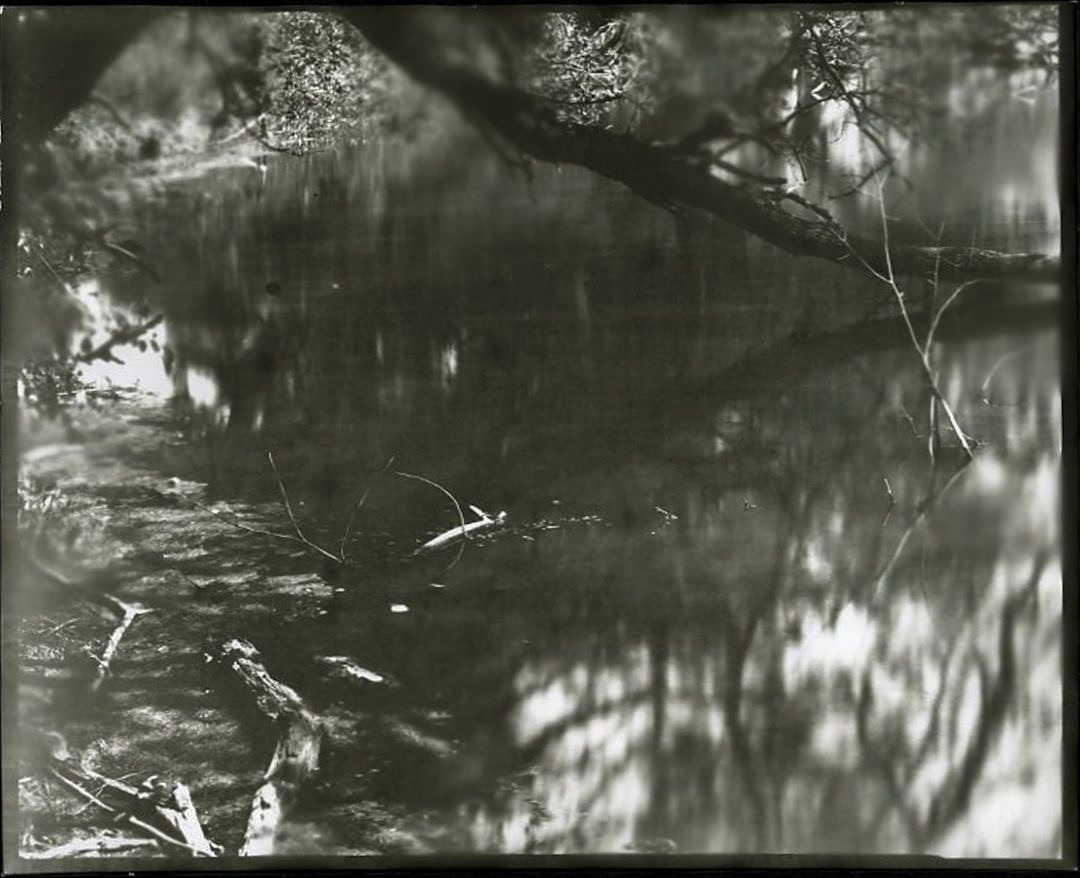
Hillary Johnson
DREAM OF A LAGOON
This photograph is taken behind the Museum of Science and Industry, Chicago. a human-built landscape in violation of treaties.
8″ x 10″ view camera
Paper Negative – silver gelatin print
I use this 19th-century process both with the view camera and the paper as a means of slowing down the act of perception, which leads to making the photograph. The impulse to make an image comes from a process of slow looking, attending to internal experience, which is seeking an outward expression. This happens both formally, in how I am composing and choosing the places I am going, but also as a way of pushing back against the speed of digital technology, fraught as it is given the entangled webs of extraction technologies and companies whose successes are based in privately held profits often at the expense of the communities across their supply chains and other loci of work.
My choice to use these materials rather than digital media reflects a desire to mindfully use with care the physical materials required. It also represents a closer relationship to the natural world, which is its source, trees, water, etc. I also am thinking about the way that method I use for making images is tied directly to notions of slowness. The ISO of the paper is about 3, meaning my exposures often take minutes, lending a temporal quality to the work, which creates a very different kind of image than a smart and fast digital camera would never be able to produce.
We see the passage of time in a very special way. The parts of the landscape which are more fixed, the heavier parts of the tree, are in sharp focus throughout the picture plane, while the water and the reflections give a dreamy quality to the image. This invites the viewer to consider the landscape and their relationship with it, to live in reciprocity rather than greed, not as a colonist just moving through but as an indigenous being entwined with all others now & in the future.
From the Think Resilience course, Social Justice / Equity / Ownership: “A truly resilient community must foster equity and democracy, as well as ecological renewal.”
©2023 Hillary Johnson
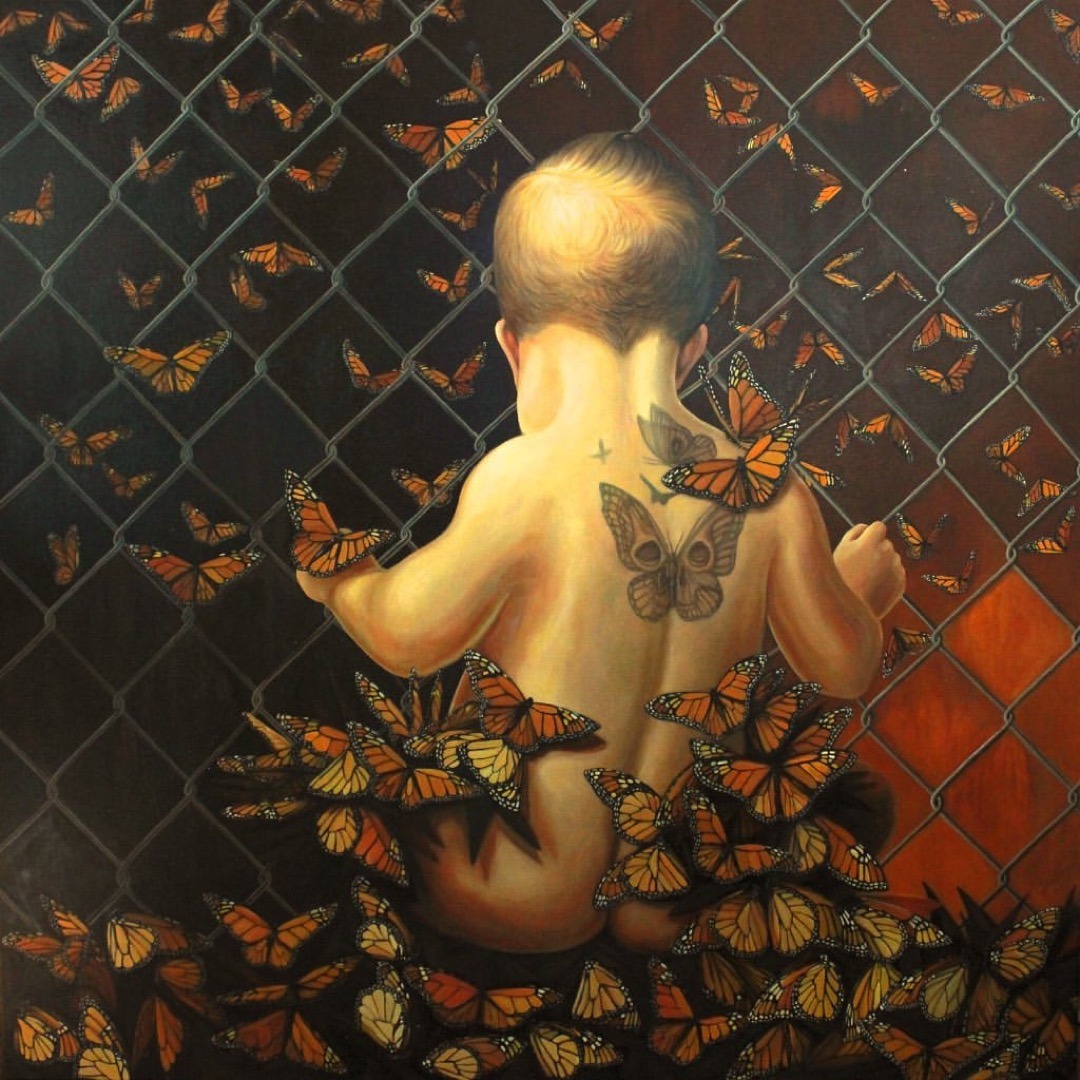
Marie Cameron
LA MARIPOSA
Oil on canvas
48” x 48”
I painted La Mariposa in response to the incarceration of migrant children at the southern US border, using the monarch butterfly as a symbol of natural migration.
Migration becomes key to survival if basic needs are not being met in one’s environment. It is only natural. If countries wish to reduce migration they should think in terms of helping to foster global equity, democracy and social justice to reduce the need to migrate rather than go to such extremes to stem it!
The Post Carbon Institute’s chapter on Community Resilience and Social Justice / Equity / Ownership speaks to this in the following quote…
“Resilience and sustainability require justice. Therefore much of the leadership for resilience-building efforts must ultimately come from communities on the frontlines of ecological disruption. These communities know that solving one problem by worsening another is self-defeating. A truly resilient community must foster equity and democracy, as well as ecological renewal.”
©2023 Marie Cameron

Nancy D Lane
DETAINED
Wall sculpture created from parts of locks, keys, barbed wire, grid, washers and wood, all found on the streets of Melbourne
14 x 37 cm
In his Think Resilience course, Richard Heinberg states: “Capital inevitably tends to reproduce itself and become more consolidated and centralized over time…. Over all, resources and wealth tend to flow from poor nations to rich nations.”
Currently there are increasing numbers of desperate people from poor nations seeking to better their lives and the lives of their families by following the money—seeking to enter developed countries through whatever means possible. They are taking extreme risks to cross into southern Europe and Australia on overcrowded boats, or into the US on foot over the Mexican border.
Sadly, some perish in the attempt, and even more are detained once they reach the ‘promised’ land. Social justice requires expanding the commons so that resources of a country are accessible to all its members, and people no longer have to endanger their lives or their freedom to improve their standard of living.
©2023 Nancy D Lane
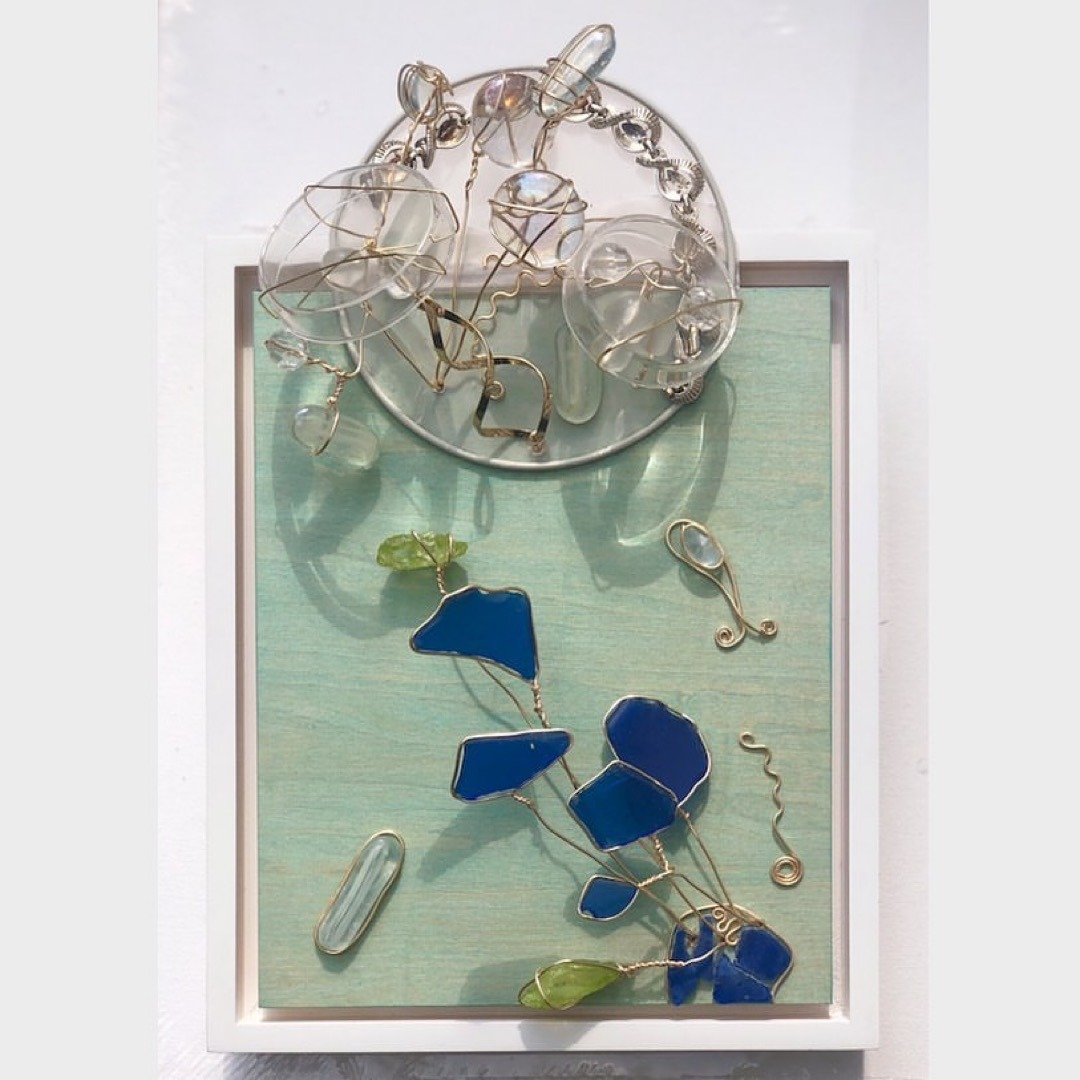
Yvonne C. Espinoza
REFLECT, REVEAL, REFINE 1
Glass, metal wire, porcelain on wood
14” H x 9.5” W
“Resilience and sustainability require justice.”-Richard Heinberg
As a forager, we learn certain rules around picking, berries, mushrooms, or herbs.
We leave some for the animals (who are also great at spreading around the seeds), for others, and for replenishment (so the plant will continue to return and thrive).
One could apply these rules to all our natural resources, including forests, oceans, animals, and even oil.
It is counter-productive to pick all the berries, or cut entire forests, or put all the garbage in the oceans.
While it may seem that mankind has “leveled-up” and has moved beyond the confines of nature and achieved a status that does not require the earthly “ball and chain”, and that our human ingenuity has once again outwitted Mother Nature, this is a great disconnect.
Though this may be the impetuous youth stage of humanity, there is an entire history of teachings from around the world we can learn from.
As beings with a relatively short life span, decisions regarding the items we buy, use, or live with every day may help one to consider what one would allow into our bodies and lives or that of our children’s. Hopefully, it can grow to include our neighbors (human and non-human).
True social justice includes connection with our natural resources, including healthy food, clean air, and safe water. This would be for everybody.
Bring on the great reconnect.
©2023 Yvonne C. Espinoza
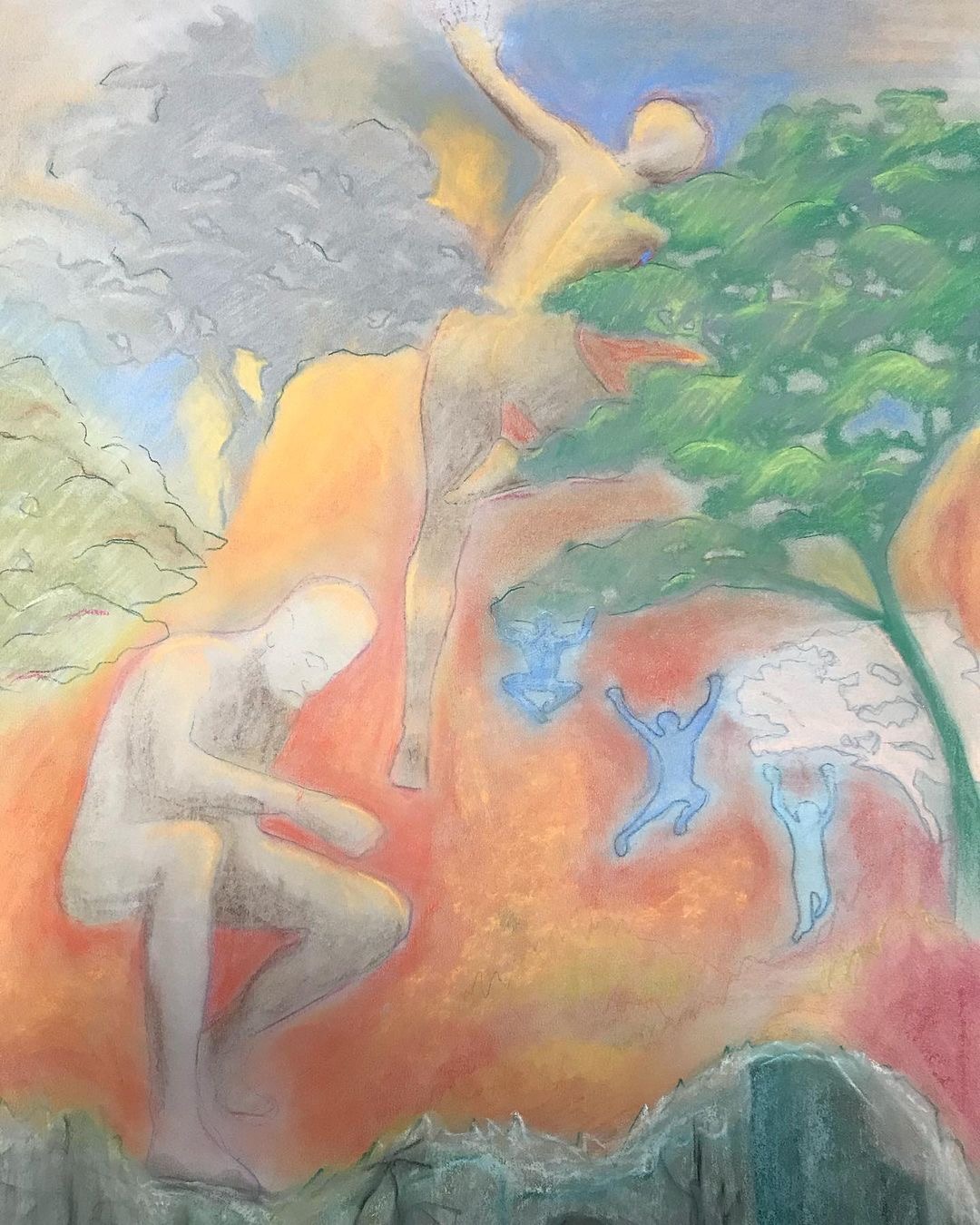
Kirsten Aaboe
WE ARE ALL INSIDE OUT
Pastel on paper
18” x 24”
Divide and Conquer: not a winning strategy in the long run. The rich and powerful are getting farther and farther out onto branches of a tree that’s losing hold of the ground in the Commons. People and life as a whole are reduced to bits and bytes when resources are hoarded and parsed out by corporate interests, determined by market theories and algorithms.
The beauty of thinking globally and acting locally is that community and responsibility are intertwined. One isn’t divorced from the other. We are connected, in truth, however disconnected we might feel.
To achieve social justice: “…To gain a historical and systemic perspective, it’s helpful to think about wealth inequality in terms of what’s known as the commons—the cultural and natural resources that are accessible to all members of a society, and not privately owned. In most pre-industrial economies, the commons included sources of food as well as natural materials for making tools and building shelters. Everyone who used the commons had a stake in preserving it for the next generation. During and especially after the Middle Ages in Britain and then Europe, common lands were gradually enclosed with fences and claimed as private property by people who were wealthy and powerful enough to be able to defend this appropriation by law and force of arms. During the past century the trend toward privatization has spread to encompass practically the whole world. The result is that people who would otherwise have been able to subsist on common resources now must buy or rent access to basic necessities. Again, the rich get richer, while the poor fall further behind….” Think Resilience, Chap. 18 excerpt.
©2023 Kirsten Aaboe
About the Think Resilience Course
This exhibition is based on Think Resilience, Post Carbon Institute’s free online course. To respond to the art call, we asked the artists to signup and to watch the course, one lesson/video at a time. Each video is approximately 12 minutes long.
[Lesson 1: Introduction to the course]
CHAPTER 1: Our Converging Crises
- Lesson 2 – Energy
- Lesson 3 – Population and Consumption
- Lesson 4 – Depletion
- Lesson 5 – Pollution
CHAPTER 2: The Roots and Results of Our Crises
- Lesson 6 – Social Structure
- Lesson 7 – Belief Systems
- Lesson 8 – Biodiversity
- Lesson 9 – Collapse
CHAPTER 3: Making Change
- Lesson 10 – Thinking in Systems
- Lesson 11 – Shifting Cultural Stories
- Lesson 12 – Culture Change & Neuroscience
CHAPTER 4: Resilience Thinking
- Lesson 13 – What is Resilience?
- Lesson 14 – Community Resilience in the 21st Century
- Lesson 15 – Six Foundations for Building Community Resilience
CHAPTER 5: Economy and Society
- Lesson 16- How Globalization Undermines Resilience
- Lesson 17- Economic Relocalization
- Lesson 18- Social Justice
- Lesson 19- Education
CHAPTER 6: Basic Needs and Functions
- Lesson 20- Meeting Essential Community Needs
- Lesson 21- Resilience in Major Sectors
- Lesson 22- Review, Assessment & Action
Think Resilience is hosted by Richard Heinberg, one of the world’s leading experts on the urgency and challenges of moving society away from fossil fuels.
We live in a time of tremendous political, environmental, and economic upheaval. What should we do? Think Resilience is an online course offered by Post Carbon Institute to help you get started on doing something. It features twenty-two video lectures—about four hours total—by Richard Heinberg, one of the world’s foremost experts on the urgency and challenges of transitioning society away from fossil fuels. Think Resilience is rooted in Post Carbon Institute’s years of work in energy literacy and community resilience. It packs a lot of information into four hours, and by the end of the course you’ll have a good start on two important skills:
1. How to make sense of the complex challenges society now faces. What are the underlying, systemic forces at play? What brought us to this place? Acting without this understanding is like putting a bandage on a life-threatening injury.
2. How to build community resilience. While we must also act in our individual lives and as national and global citizens, building the resilience of our communities is an essential response to the 21st century’s multiple sustainability crises.
What’s Next For Earth is an art project created in March 2020 by Michele Guieu, eco-artist, and MAHB Art Editor, to understand the human predicament and reflect on the ecological emergency to take action. The project is supported by the MAHB and the Post Carbon Institute. If you have any questions, please send your message to michele@mahbonline.org.
Thank you ~

